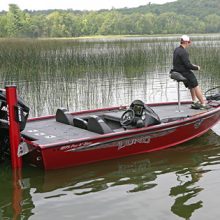This article may contain affiliate links. If you make a purchase after clicking on a link we may earn a small commission at no extra cost to you. As an Amazon Associate, I earn from qualifying purchases.
Flipping and Pitching for Bass

Flipping and pitching for bass are two of the most fundamental casting techniques to master if you are to truly progress you bass fishing skills.
They are both close quarters fishing approaches that allow you to get both a highly accurate cast and a quiet entry for your lure or jig.
A lot of anglers confuse the two terms and will regularly describe pitching as flipping and vice versa
You will usually be close in to your intended target so they are best used in and around heavy weed cover or during dirtier water times.
In clear water you will not have the kind of range needed to remain out of site of bass and a spooked bass will rarely strike.
Soft entries are the name of the game as you want to reduce the amount of splash or any other noise/sound that may make fish wary.
Flipping and Pitching
Flipping involves pulling a length of line off your spool with your free hand and then swinging your lure out front whilst feeding the line through the rod, pitching on the other hand involves a light underhand cast with the spool disengaged.
Both techniques do take a little time to master and the best way is to practice, practice, practice.
You can do this in you yard or on your lawn. Set up a few small target or markers on the lawn and then with a lead shot on the end of your line that is similar in weight to you lures start to practice each technique.
Once mastered they will become like second nature and you will wonder how you lived with out them.
Flipping for Bass
Flipping is the shorter of the two casting techniques and in my mind is usually a little more accurate once mastered.
It is particularly effective at making a super soft entry with little or no splash.
It differs from pitching in that the spool is always engaged and line is pulled off of it by your free hand so you will need to set your drag accordingly.
Because of this it has a limited range and depends a little on your height and length of rod.
The best flipping rod to use will be one with a fast action so that you can load up the rod tip allowing it to transfer any power from the swing down to the lure.
You can flip on spinning gear if you are looking for really finesse presentations but the majority will use a baitcasting rod and reel as their flipping setup.
How to Flip for Bass ?
Flipping involves pull line off of your spool in your free hand so that your arm is extended straight out to the side and slightly behind you body.
With your rod tip raised you should have your lure in line with your reel.
You then swing the lure outwards away from your body and towards your target.
As you do this you should feed the line through the first eye of the rod allowing the lure to flip forwards.
Never let go of the line completely, instead let it run through your fingers as you move your hand back towards the reel.
Letting go of the line completely means less over all control. When you control how quickly the line runs through the rod you can fine tune your distance with a lot more accuracy.
Pitching for Bass
When pitching for bass you definitely have a longer range available than when flipping as you are effectively casting with an underhand cast with the spool free running.
This longer range can be a better bet in clearer waters that require you to maintain a bit more distance from the bass.
How to Pitch for Bass ?
Pitching is just a normal cast but you do so with an underhand swing forward of the lure.
To start you can hold the lure in your free hand when you are first learning the technique.
Once you are a bit more experienced you can just swing the lure out with the right amount of force and speed but get the basic technique down first.
Release the spool as normal and thumb down on your spool, holding the lure in your free hand(behind the hook otherwise you will get snagged) swing it forwards and use you thumb to control the distance by thumbing the spool.
Pitching is always down with a baitcaster as on spinning gear it is just too awkward.
